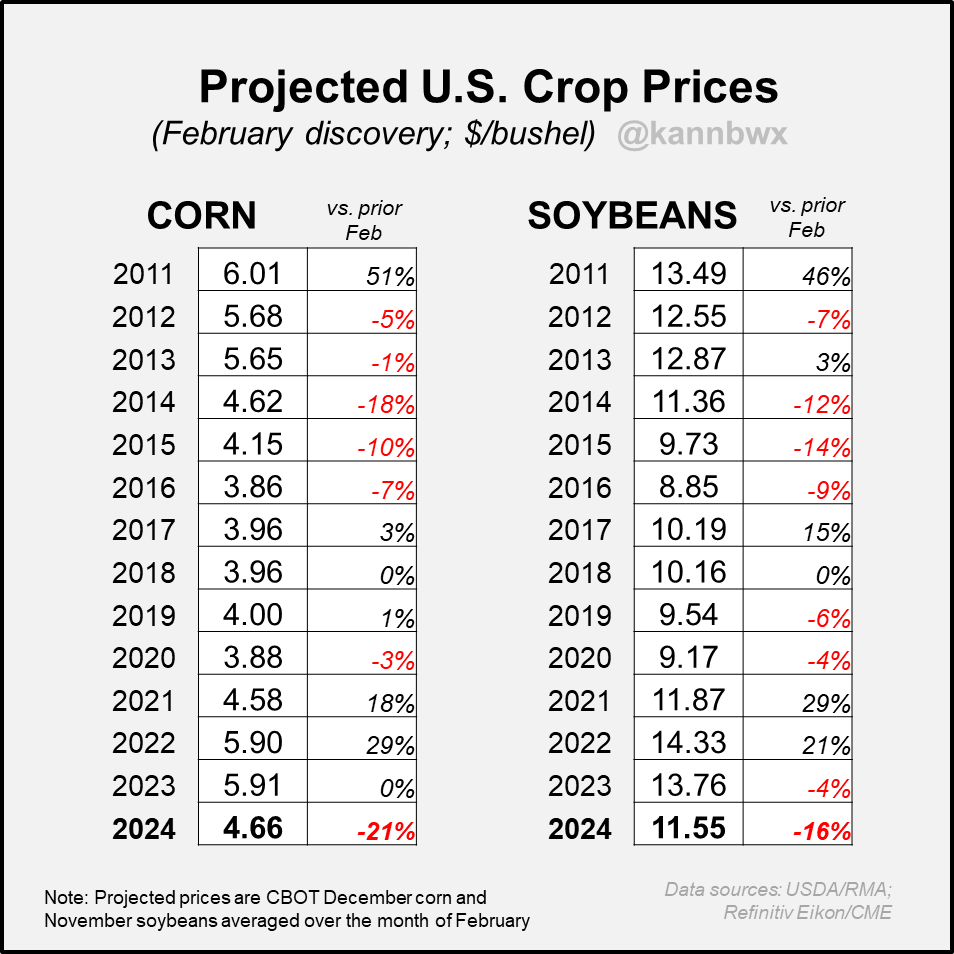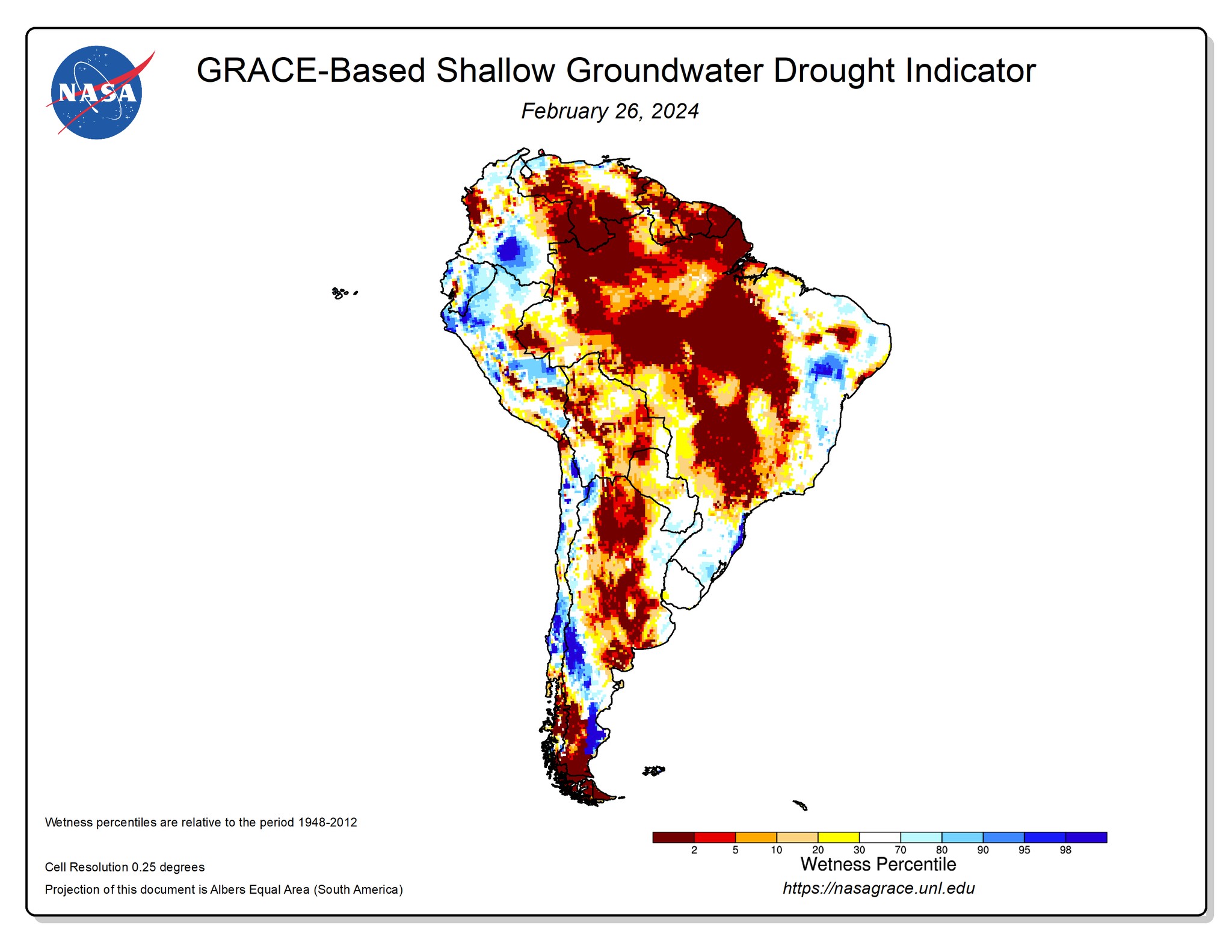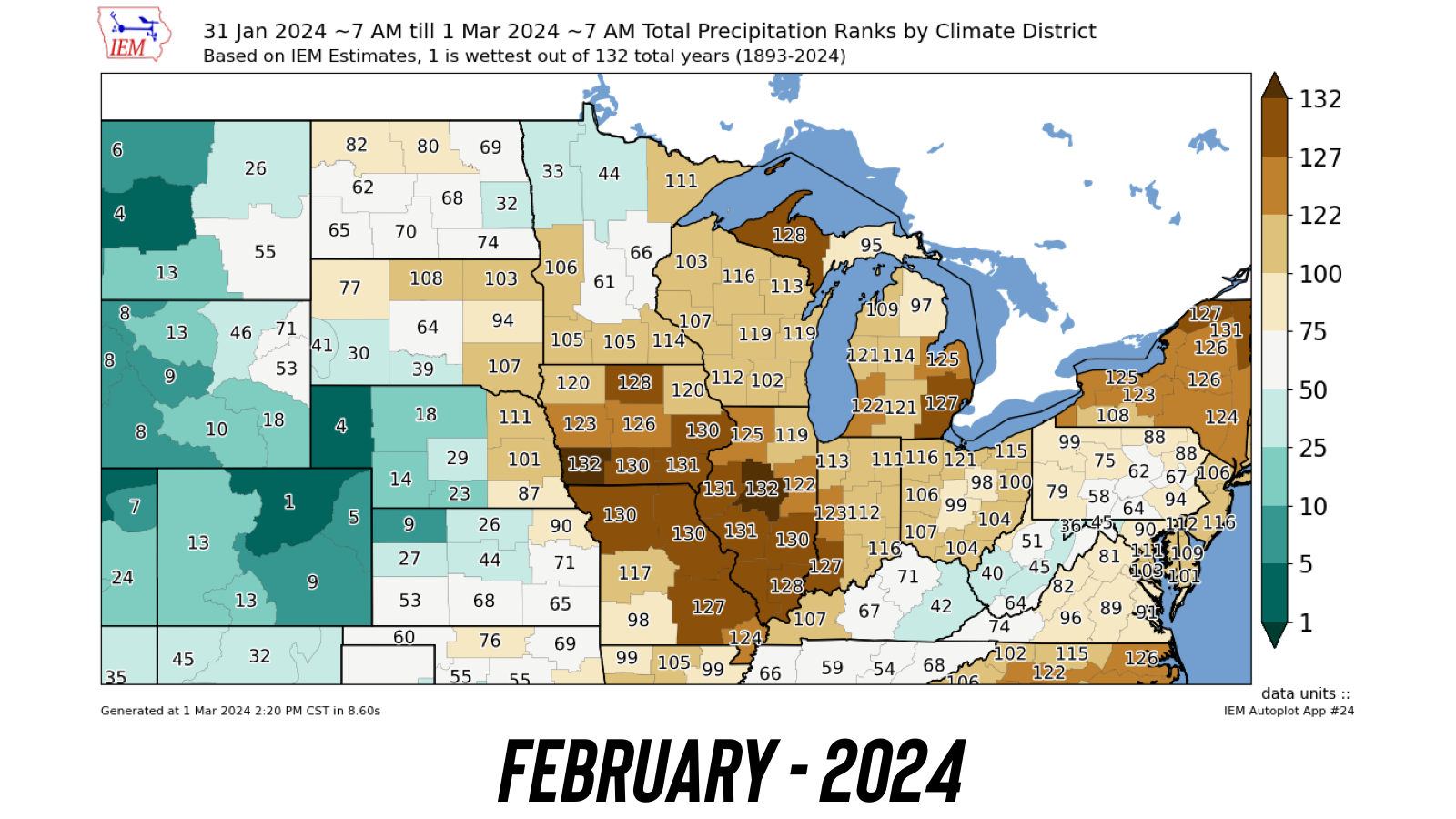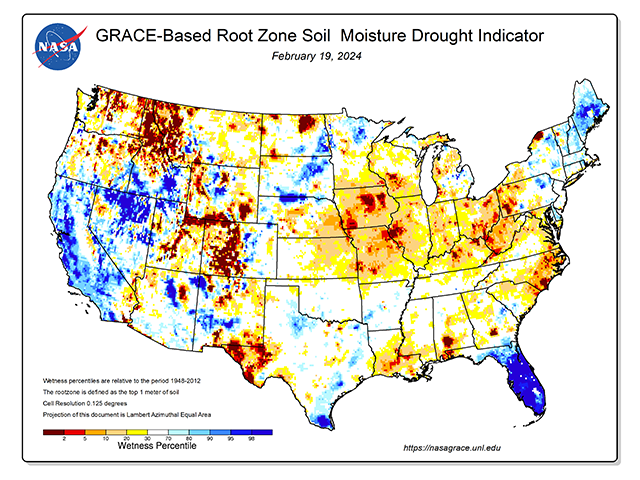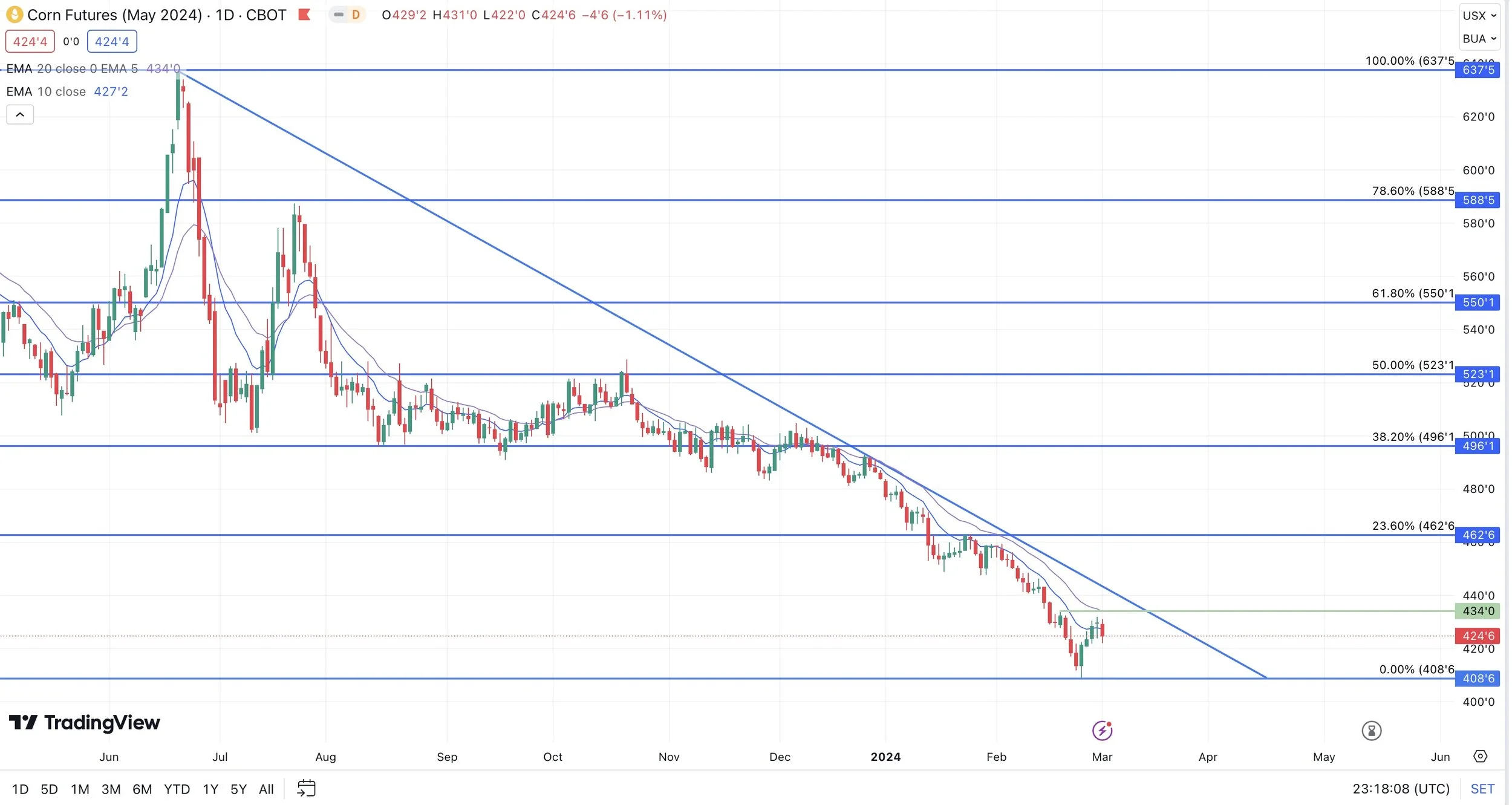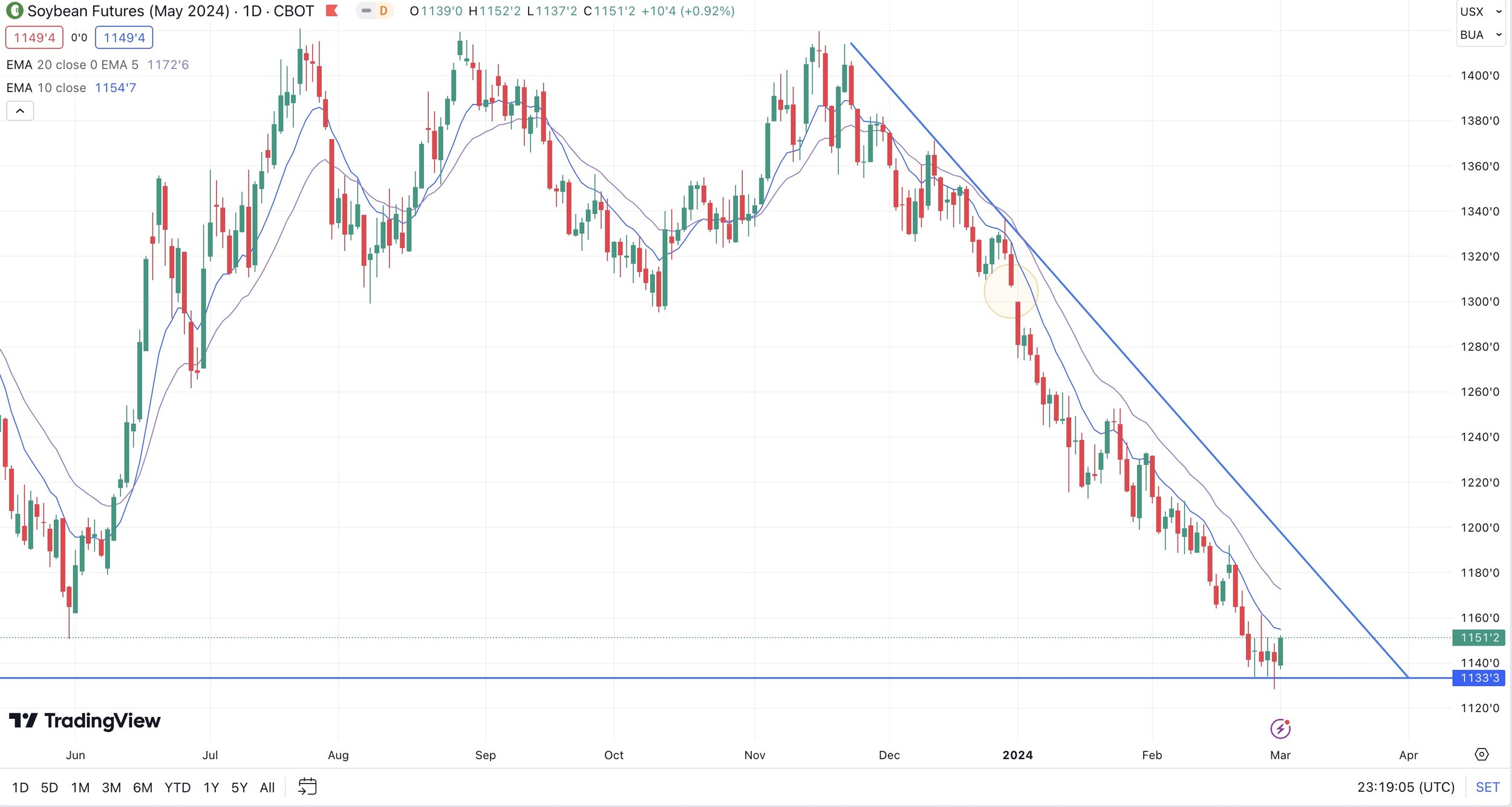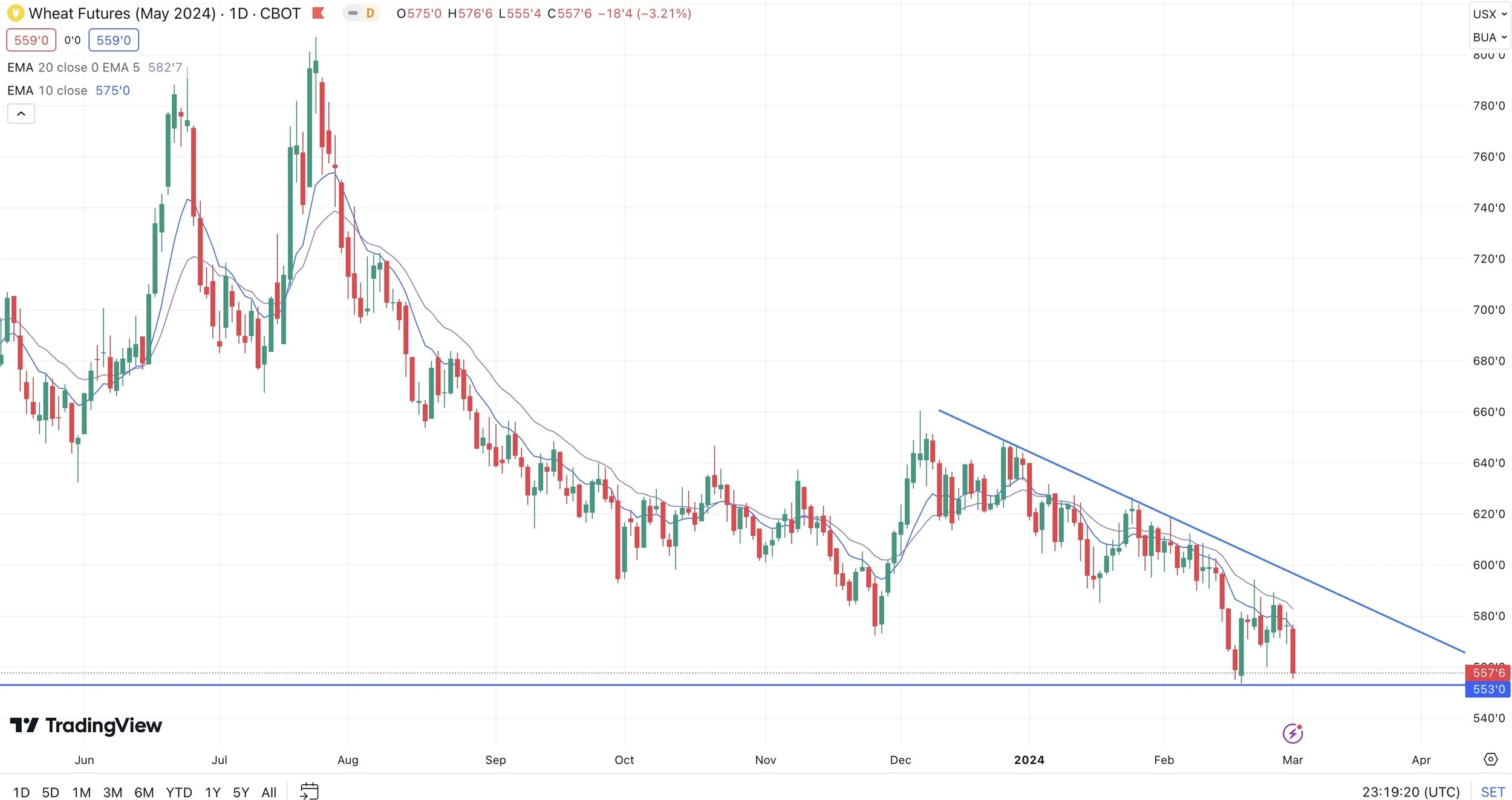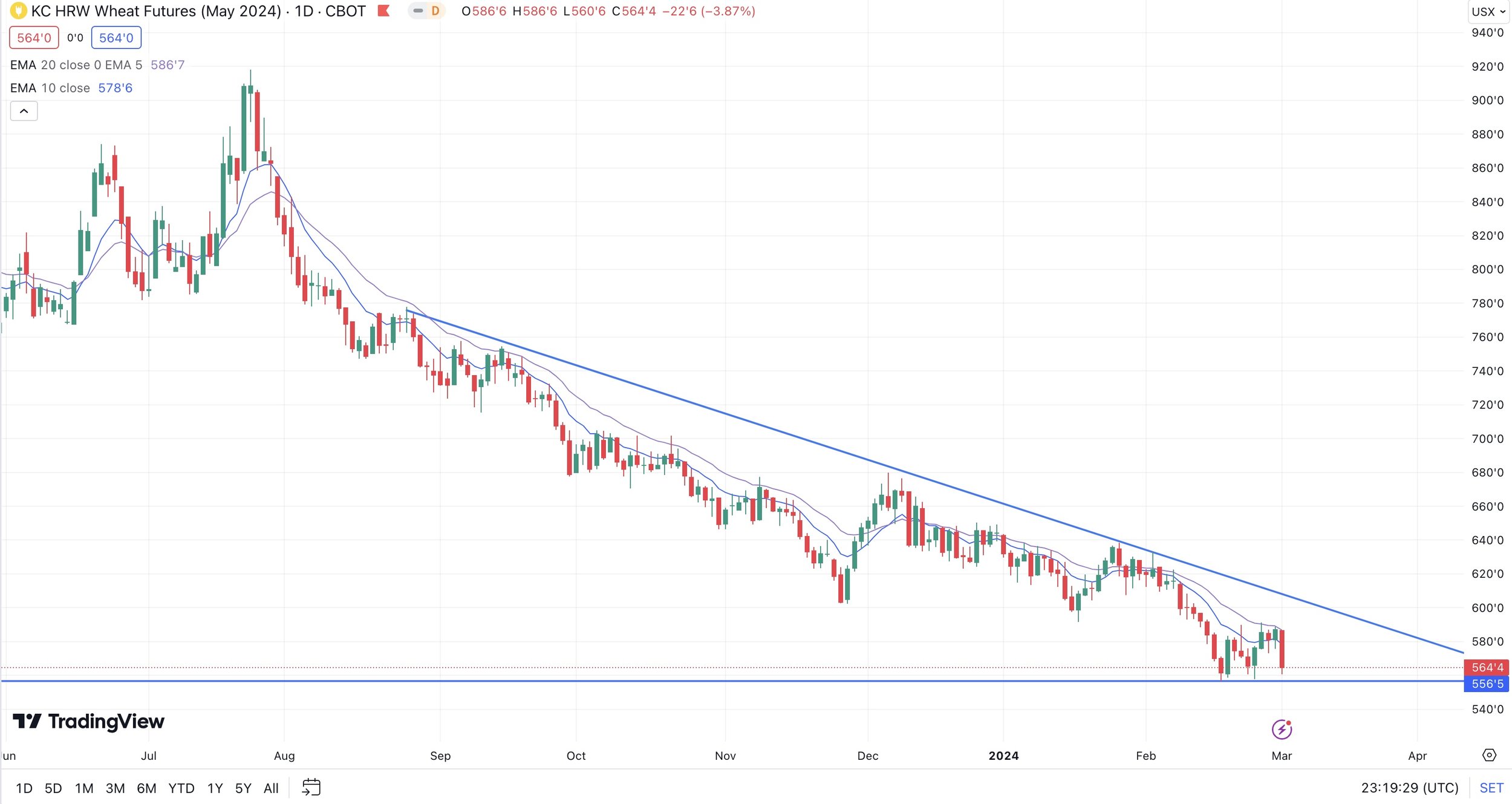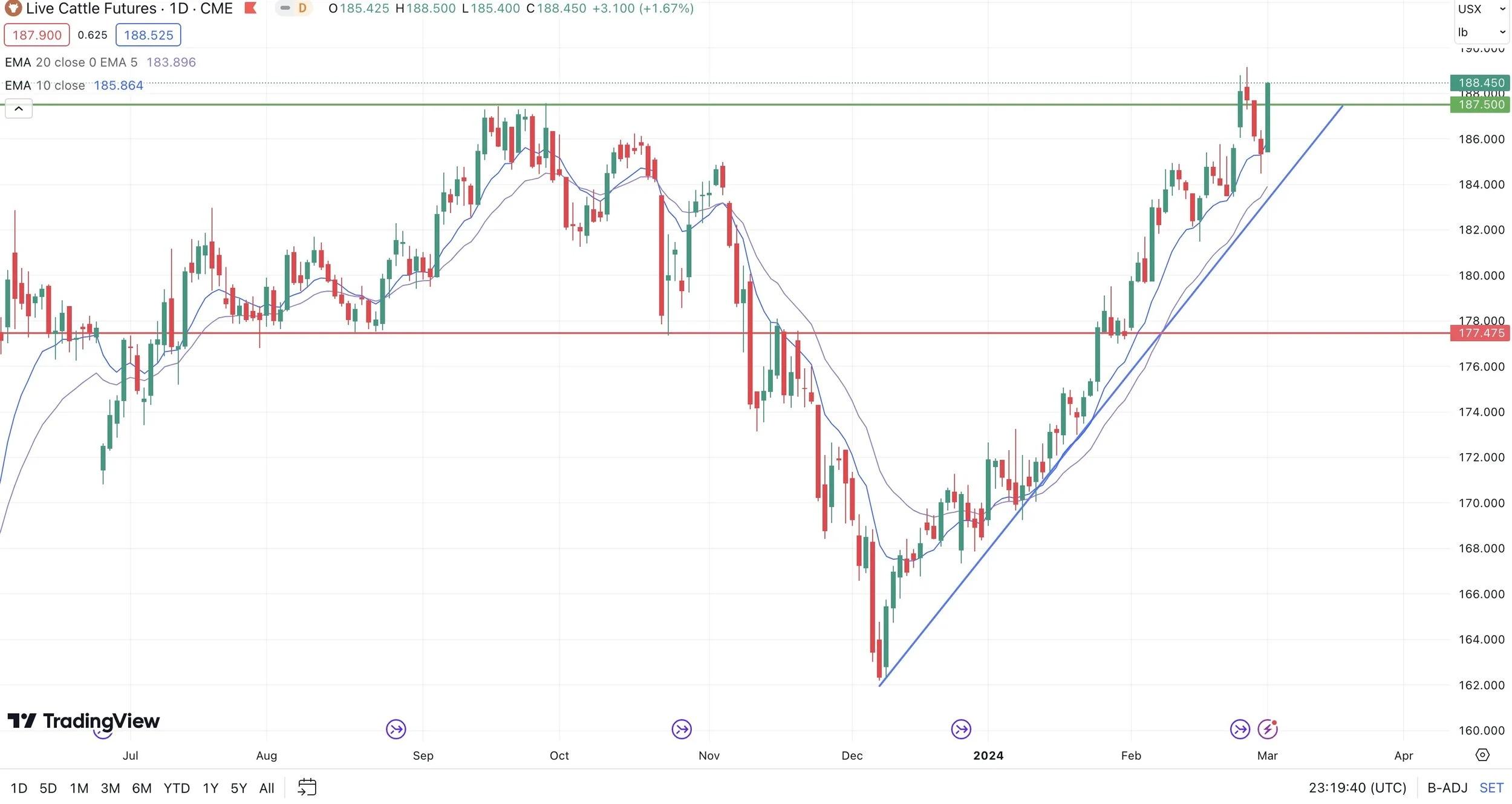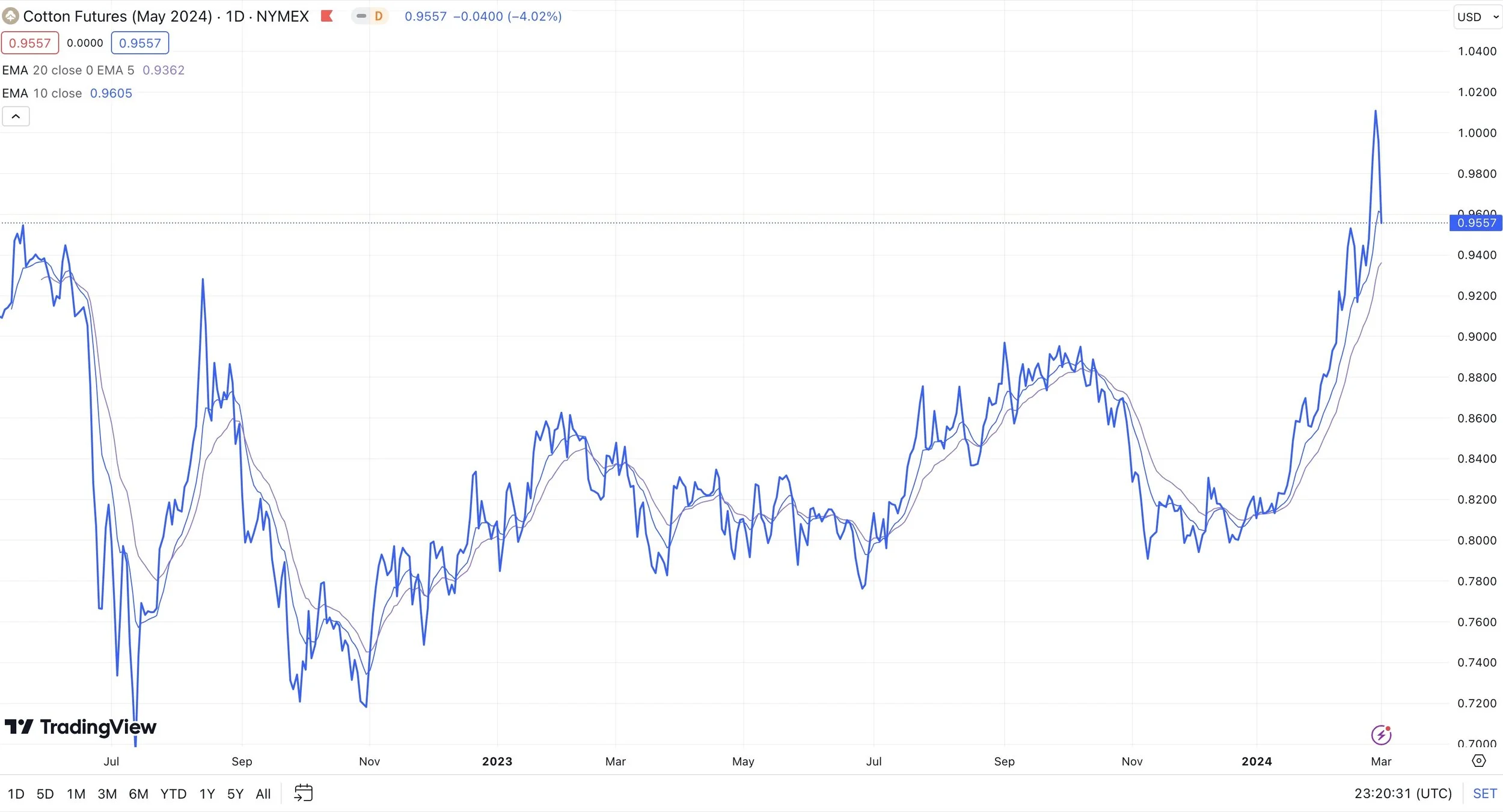FIRST HIGHER WEEK IN MONTHS
Overview
Grains mixed as soybeans rally. Corn fails to take out last weeks high of $4.34 to complete it's weekly reversal. The wheat market gets hammered looking to test those recent lows as wheat posted a new low close.
After 16 brutal weeks, this was soybeans first week higher since October. Soybeans were up +9 1/2 cents on the week.
This was also corns first week higher since early December. Corn was up +11 1/4 cents on the week.
With the fall out today, Chicago wheat was down -11 1/4 cents on the week while KC wheat was only down -1 cent.
The pressure in wheat today came from matif wheat in France falling to their lowest levels since 2020. This was due to ample supply in Russia along with no issues getting grain out of Ukraine. This dragged down our wheat market and some of this weakness spread into the corn market as well.
Insurances prices got set today. Here is the results:
Corn: $4.66
Beans: $11.55
Chart Credit: Karen Braun
It felt like there was a lot of pricing heading into first notice day. The market drove us lower to force farmers to sell ahead of that. Then after they sold, we bounced. There was a lot of people racing to sell basis contracts.
Everybody knew the farmer had a lot of basis contracts that needed to be priced or rolled going into first notice day.
I wonder if it was big ag selling ahead of time, pressing the market down because they knew you would be forced to sell or roll. Would anyone put that past your buyer to do?
There are several people that mention it was a race to drive the market to new lows before first notice day. Sometimes it feels like it is the farmers vs everyone. Big ag, the funds, the USDA, etc. The greatest trick the devil ever played was convincing people he wasn't real.
Ways to NOT Manage Risk
The first thing I wanted to talk about today is ways you should NOT be managing your risk this time of year in my opinion.
With prices depressed and implied volatility low, right now is not the time to be using strategies that use short implied volatility because seasonally as we get into March, our markets can get more volatile with the ending of bean harvest in South America and as we roll into the second corn crop growing season portion where we determine what they are going to raise.
This time frame for their second corn is the equivalent to our July. Then we have the March 31st USDA acre report.
Then when we really get into our growing season, this will all add to volatility. So you will want to stay away from the crap some of these buyers try to sell you such as accumulators.
The time to do accumulators and to sell calls is when implied volatility gets higher. Typically it starts to raise from now until we get into June and July. The best time to use accumulators will typically be in June and July, which is typically the weather scare season.
So this is one way not to get taken advantage of by Big Ag. Do not use accumulators or sell calls when implied volatility is low. Implied volatility means the market is not expecting big moves which lowers the price of options.
If you have questions, before you do an accumulator with a buyer that may have motivation to buy your grain cheap. Give us a call because we will give you an unbiased opinion. (605)295-3100
South America
Which brings me to my next topic. South America.
This has been partly a reason why corn and soybeans have struggled to find momentum. As there isn’t a major threat right now and soybean harvest is moving along well. But could that change?
South America as a whole, should produce an okay soybean crop. However, the recent yield reports from Brazil are showing yields a little worse than expected. This is giving soybeans some support around this $11.30 level.
Keep in mind, fast harvest is not always a good thing. What does a fast harvest usually mean? It means it is dry.
Now the biggest concern with this is their second crop corn. Remember, this corn got planted late. Which pushes the crop into a less favorable growing window and puts the crop at risk.
The forecasts remain dry looking longer term and they already lack soil moisture. If it does not rain, that corn crop could take a big toll.
April is the month where this second corn crop pollinates and their seasonal drought begins. They have missed a ton of rain, and have the lowest subsoil moisture situation on record.
There are several advisors that believe this could be the catalyst corn needs.
The market may not realize it now, but they will if it stays hot and dry. If this happens, will likely take place in late April or May. Similar to that of 2016.
US Weather
Next let's look at the US weather.
As I have been talking about for a week now, warmest winter on record. Lack of precipitation.
But what does this mean?
In February it doesn’t mean anything.
But if this trend continues, it could be a major wild card for the bulls.
Here is the temperature and precip ranks for February this year.
Here is how March, April, and May looked for 2012.
Here is the drought monitor comparison.
I only point this out to showcase how dry our situation already is in the corn belt.
From Farms.com Risk Management:
"2012 drought was very dry early, like in 2024, but not as hot. The 2024 start is much worse especially for the midwest. Drought levels of moderate to extreme expect to worsen as La Nina approaches."
Our soil moisture situation is already lacking.
I am NOT saying this is a repeat of 2012. It is only February.
I am pointing out the possibilities if this trend continues.
The outlook for this spring and summer is dry, as La Nina is supposed happen.
This warm and dry weather is going to very likely bring early planting.
When early planting happens, we usually do not get a planting scare. Instead, planting will be going along well and they will probably try to push this market lower into spring. Just like they did last year and in 2012.
Then if this hot and dry pattern continues, they will realize oh planting is going good because it's dry.
Which then brings the possibility for drought talk. All it takes is the "chance" for drought to spark a rally. Like year. If the drought actually happens, well you get price action like 2012. I am not saying we will see that big of rally, because we do have this massive carryout weighing on the market. But this could provide a great pricing opportunity.
Remember last year, if we did not get that timely rain like we did, a lot of the crop would’ve cooked. We also had those wild fires in Canada which helped shield the crops from the heat.
Later in today's update I will share what I think this means for the future of corn prices into spring and summer.
Overall, this market is by no means in "rally mode", but this week has sent some signals that a bottom is forming.
Let's jump into the rest of today's update..
Today's Main Takeaways
Corn
Corn lower today as we missed that key reversal in May. But we did have an outside bullish week on the December contract. Also on the bright side we did end the week higher for the first time in months as mentioned.
The biggest thing today was the weakness from wheat leaking over into corn.
The reason for the recent mini rally is the funds. They just held the largest short position EVER. It was time for them to cover some of those shorts. We also just had a lot of farmer puke selling that may be over for now, as we are into road limits.
We also got some good weekly export sales and the talk about the potential problems with the second corn crop is starting to grow.
The biggest concern in the corn market is the USDA's projected 91 million acres for corn. If this actually happens there will be talk about a +3 billion bushel carryout.
How do I think this entire planting situation and warm weather is going to play out for corn?
A wise man told me yesterday that "the first rally never holds". Similar to when we are at the top of the market, the first sell off never holds. There is always a pullback or bounce after the first move.
I think this first rally will provide corn support into late March. I'd say we have anywhere from +20 cents to maybe +40 cents.
Then once we get into late March or early April, all the talk is going to be about this early planting and how things are going great along with talk about high acres. If this happens, it lowers the chance for that usual planting scare we sometimes get.
Instead, this fast planting will likely heavily pressure the market. We could give back half of what this first rally gives us. We could even give back the entire thing and test the recent lows we just made.
However, when we get into June everyone is going to realize our planting was so fast because it is dry. We will lack all of this soil moisture. The same thing happened in both last year and 2012. We were hot and dry in spring, and this market went lower until it realized why were planting fast.
The forecasts are calling for well above normal this summer. Because we are entering a La Nina cycle which scientifically brings hotter and drier temps to the corn belt.
If it stays hot and dry, we will get that weather scare rally. This will provide a great pricing opportunity. If the drought "actually" materializes we could have more than just a scare.
Now this doesn’t even take into consideration the possible scare we could see from the second corn crop in Brazil. If they do indeed get a crop that is toast, it will likely rally the markets starting in late April to May.
So how should you be managing your risk right now?
We see potential volatile markets going forward so that means that some of you should be considering courage calls, while others might want to consider re-ownership strategies after all it is BUY LOW and SELL HIGH. Presently we have very low implied volatility (which means buying options cheap which is also BUY LOW and SELL HIGH) and we have prices at the low in comparison to any sales made the past couple of years.
We have previously talked about courage calls and re-ownership calls. We also try not to give generic one size fits all recommendations. So please reach out to Wade at 605-870-0091 or Jeremey at 605-295-3100 and they can help you determine if either one of them might be right for your situation.
For those of you looking for a little more specific those that don’t have bins and have to presell a large percentage of new crop should be considering the courage calls, while others are probably in a situation that is slightly different
Corn Dec-24 Weekly
Corn May-24 Weekly
Corn May-24
Soybeans
Soybeans rally today, but we chopped around the entire week and still remain in a clear downtrend.
The funds hold their 2nd shortest position all-time in soybeans.
We had yet another round of very disappointing weekly export sales. Some South America soybeans have been making their way to the US which is bad from a competitive standpoint.
Then as mentioned, the harvest in Brazil is going along well. This adds harvest pressure to prices in Brazil, which in turn makes us less competitive and harms our prices. Brazil beans are still cheap in comparison to ours.
If the Brazil soybean crop is a lot smaller than the USDA seems to think, the market will not take notice for a few more weeks until harvest is closer to complete or if the USDA opts to make any big change in the upcoming report.
Right now short term, it also feels like the funds will probably look to cover their corn short rather than their soybean shorts. Because right now we do not have much going for this market until we start to see the crops from South America.
Unlike corn, we also have not seen technical indicators of a bottom in soybeans. I like our chances of making the $11.30 level a good low, but I am hesitant to say that will 100% be our low.
Looking long term, I am a big believer that we will find a greater demand story. Whether it comes from the SAF situation or else where. The potential is there. I don’t know when that demand story will come, but am remaining patient until it does.
Until we get closer to Brazil's harvest being complete in 3 weeks, soybeans could very well trade mostly sideways until then.
Soybeans May-23
Wheat
The wheat market collapsed today. We are now right back near those recent lows from a few weeks ago with just one big down day.
Wheat has been pressured from cheap wheat across the world as well as slow exports. This is keeping a lid on our prices as there just isn’t a story for bulls to chew on.
Although the prices in France just plummeted, their crop does continue to deteriorate. As their wheat crop is sitting at it's worst levels since 2020. Their crop is rated at 68% good to excellent vs last years 95%.
Winter wheat conditions here in the US are a lot better than they have been the last few years which hasn’t made a sustained rally in wheat any easier.
As has been the case for a few months now there just isn’t much going on in the wheat market. Which can often lead to sideways or lower action.
Still a sleeper and remaining patient.
May-24 Chicago
May-24 KC
Cattle
Sometimes headlines can often predict tops and bottoms of markets.
When everyone is bullish, or everyone is bearish. Sometimes it means the bandwagon is over.
Here was the cover of the Economist magazine.
The fact that I have seen this everywhere makes me more inclined to be aggressive in adding a floor to protect from downside.
I am not saying the top is in, because we could certainly go higher. But practice smart risk management near these highs.
Live Cattle
Feeder Cattle
Cotton
Huge sell off reminds us that it is always okay to practice prudent risk management. And for most of you that means using options to put a floor in place.
There is nothing wrong with taking risk off the table to get comfortable and adding a floor because of a technical trigger like this one.
Want to Talk?
Our phones are open 24/7 for you guys if you ever need anything or want to discuss your operation.
Hedge Account
Interested in a hedge account? Use the link below to set up an account or shoot Jeremey a call at (605)295-3100 or Wade at (605)870-0091
Check Out Past Updates
2/29/24
HOW TO USE TARGETS VS TRIGGERS
2/28/24
BIGGEST 3 DAYS IN CORN SINCE AUGUST
2/27/24
DID CHINA BUY CORN YESTERDAY?
2/26/24
EARLY PLANTING, DROUGHT, & FINDING YOUR GRAIN MARKETING STRATEGY
2/23/24
MORE DOOM & GLOOM AS CORN BREAKS BELOW $4.00
2/22/24
HAVING A PLAN & DEFINING RISK
2/21/24
LOWER LOWS & DROUGHT TALK
2/20/24
HOPE ISN’T A MARKETING PLAN BUT HISTORY REPEATS ITSELF
2/16/24
HAVE ENOUGH OF YOUR NEIGHBORS THROWN IN THE TOWEL SO WE CAN BOTTOM?
2/15/24
BASIS CONTRACTS & USDA OUTLOOK
Read More
2/14/24
SELL OFF AHEAD OF USDA OUTLOOK: STRATEGIES TO CONSIDER
2/13/24
LA NINA, FUNDS, & USDA OUTLOOK FORUM
2/12/24
WHAT TYPE OF GARBAGE USDA OUTLOOK REPORT IS ALREADY PRICED IN?
2/9/24
RECORD SHORT FUNDS, SOUTH AMERICA, & MANAGING RISK
2/8/24
CONAB VERY FRIENDLY. USDA NOT. FULL BREAKDOWN
2/7/24
NEW LOWS IN CORN & USDA PREVIEW
2/6/24
WHAT IS EXPECTED FROM USDA & WAYS TO GET COMFORTABLE
2/5/24
STILL NO CLEAR DIRECTIONS IN THE MARKETS
2/2/24
NEW BEAN LOWS.. HOW LOW CAN CORN GO?
2/1/24
NO CONFIRMATION OF HIGHER OR LOWER PRICES IN GRAINS
1/31/24
HOW SHOULD YOU BE SETTING YOUR TARGETS?
1/30/24
OUTSIDE UP DAY IN ALL THE GRAINS
1/29/24

